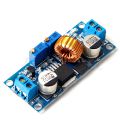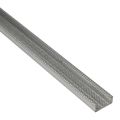Difference between revisions of "User:Mentar/LED lighting proposal"
(Updated c-channel) |
ChristianJ (talk | contribs) (PWM and UV) |
||
| Line 38: | Line 38: | ||
=== Implementation === | === Implementation === | ||
At 3.5V each LED consumes around 750ma. 5 LEDs in series would need 17.5V across them. We need 3 of these arrays to make up 15 meaning that we have a current draw of 2.25A for a total of 39.375W. Which is well within what even my weak 60W X220 thinkpad PSU can deliver. | At 3.5V each LED consumes around 750ma. 5 LEDs in series would need 17.5V across them. We need 3 of these arrays to make up 15 meaning that we have a current draw of 2.25A for a total of 39.375W. Which is well within what even my weak 60W X220 thinkpad PSU can deliver. | ||
| + | |||
| + | |||
| + | === Comments === | ||
| + | |||
| + | Sounds good to me. Good that you didn't include dimming functionality based on pulse-width modulation: I really dislike LED lights based on low frequency PWM (100 Hz or so), it can be noticed easily in many situations and makes those worse for me than gas discharge lamps (those also might trigger migraine in some people?). With proper DC and no PWM, though, they will be better than gas discharge lamps. (BTW I'm still planning to create a (rather high frequency and low-pass filtered) pulse based circuit to create adjustable DC, if I ever get around implementing that I'll tell.) | ||
| + | |||
| + | Another thing to keep in mind is that some white LEDs use ultra-violet light emitting crystals to get their phosphor to light up; those may need an UV blocking filter to make them eye safe (even if their casing blocks some UV it might not necessarily be enough for the amount used for room lighting?). Alternatively stay with blue crystals. [[User:ChristianJ|ChristianJ]] ([[User talk:ChristianJ|talk]]) 18:17, 2 January 2016 (UTC) | ||
Latest revision as of 18:17, 2 January 2016
mentar's LED lighting proposal
Given the cost and lack of reliability of the current lighting fittings at the space I'd like to propose we run a small trial with custom built LED arrays?
Approach
The approach I'm proposing is to use 3 watt star leds mounted on the inside of galvanised steel channel. The led driver is a an adjustable constant current source, this can allow us to use varied power supplies to power the strips including some of the old laptop chargers that have been gathering dust downstairs for some time.
Pros/Cons
- Pros
- Relatively cheap
- Reliable in theory (including overtemp and shortcircuit protection)
- The galvanised steel stud provides a basic reflector and heatsink while the lip allows mounting of diffusion plates. Can also be used as the ground plane, simplifying connections.
- Makes use of a range of un-needed power supplies
- Modular, so easy to replace broken parts
- Cons
- Requires some effort to put together
Costs
For an LED strip of say 15 leds (around 45 watts) 2.4m array
- LEDs: £10 (£0.66p per LED from PowerLedWorld)
- DC-DC switching converter: £2.49 (from ebay)
- 50W laptop supply: £0 as we have a few downstairs (need to count how many we have!)
- Galvanised Steel C-Channel: £3.73 per 3m (from Builder depot)
Total cost: ~ £16.30 (to compare 8ft 100W fluorescent tube only, no fittings! costs £15.59 on LampsOnline)
Implementation
At 3.5V each LED consumes around 750ma. 5 LEDs in series would need 17.5V across them. We need 3 of these arrays to make up 15 meaning that we have a current draw of 2.25A for a total of 39.375W. Which is well within what even my weak 60W X220 thinkpad PSU can deliver.
Comments
Sounds good to me. Good that you didn't include dimming functionality based on pulse-width modulation: I really dislike LED lights based on low frequency PWM (100 Hz or so), it can be noticed easily in many situations and makes those worse for me than gas discharge lamps (those also might trigger migraine in some people?). With proper DC and no PWM, though, they will be better than gas discharge lamps. (BTW I'm still planning to create a (rather high frequency and low-pass filtered) pulse based circuit to create adjustable DC, if I ever get around implementing that I'll tell.)
Another thing to keep in mind is that some white LEDs use ultra-violet light emitting crystals to get their phosphor to light up; those may need an UV blocking filter to make them eye safe (even if their casing blocks some UV it might not necessarily be enough for the amount used for room lighting?). Alternatively stay with blue crystals. ChristianJ (talk) 18:17, 2 January 2016 (UTC)


